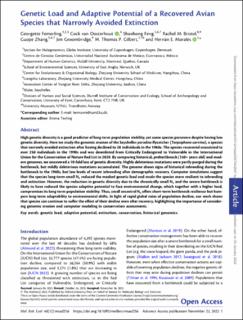| dc.contributor.author | Femerling, Georgette | |
| dc.contributor.author | van Oosterhout, Cock | |
| dc.contributor.author | Feng, Shaohong | |
| dc.contributor.author | Bristol, Rachel M. | |
| dc.contributor.author | Zhang, Guojie | |
| dc.contributor.author | Groombridge, Jim | |
| dc.contributor.author | Gilbert, Marcus Thomas Pius | |
| dc.contributor.author | Morales, Hernán E | |
| dc.date.accessioned | 2024-02-13T13:10:14Z | |
| dc.date.available | 2024-02-13T13:10:14Z | |
| dc.date.created | 2023-12-18T12:39:33Z | |
| dc.date.issued | 2023 | |
| dc.identifier.citation | Molecular Biology and Evolution (MBE). 2023, 40 (12), . | en_US |
| dc.identifier.issn | 0737-4038 | |
| dc.identifier.uri | https://hdl.handle.net/11250/3117320 | |
| dc.description.abstract | High genetic diversity is a good predictor of long-term population viability, yet some species persevere despite having low genetic diversity. Here we study the genomic erosion of the Seychelles paradise flycatcher (Terpsiphone corvina), a species that narrowly avoided extinction after having declined to 28 individuals in the 1960s. The species recovered unassisted to over 250 individuals in the 1990s and was downlisted from Critically Endangered to Vulnerable in the International Union for the Conservation of Nature Red List in 2020. By comparing historical, prebottleneck (130+ years old) and modern genomes, we uncovered a 10-fold loss of genetic diversity. Highly deleterious mutations were partly purged during the bottleneck, but mildly deleterious mutations accumulated. The genome shows signs of historical inbreeding during the bottleneck in the 1960s, but low levels of recent inbreeding after demographic recovery. Computer simulations suggest that the species long-term small Ne reduced the masked genetic load and made the species more resilient to inbreeding and extinction. However, the reduction in genetic diversity due to the chronically small Ne and the severe bottleneck is likely to have reduced the species adaptive potential to face environmental change, which together with a higher load, compromises its long-term population viability. Thus, small ancestral Ne offers short-term bottleneck resilience but hampers long-term adaptability to environmental shifts. In light of rapid global rates of population decline, our work shows that species can continue to suffer the effect of their decline even after recovery, highlighting the importance of considering genomic erosion and computer modeling in conservation assessments. | en_US |
| dc.language.iso | eng | en_US |
| dc.publisher | Oxford University Press | en_US |
| dc.rights | Navngivelse 4.0 Internasjonal | * |
| dc.rights.uri | http://creativecommons.org/licenses/by/4.0/deed.no | * |
| dc.title | Genetic Load and Adaptive Potential of a Recovered Avian Species that Narrowly Avoided Extinction | en_US |
| dc.title.alternative | Genetic Load and Adaptive Potential of a Recovered Avian Species that Narrowly Avoided Extinction | en_US |
| dc.type | Journal article | en_US |
| dc.type | Peer reviewed | en_US |
| dc.description.version | publishedVersion | en_US |
| dc.source.pagenumber | 15 | en_US |
| dc.source.volume | 40 | en_US |
| dc.source.journal | Molecular Biology and Evolution (MBE) | en_US |
| dc.source.issue | 12 | en_US |
| dc.identifier.doi | 10.1093/molbev/msad256 | |
| dc.identifier.cristin | 2214828 | |
| cristin.ispublished | true | |
| cristin.fulltext | original | |
| cristin.qualitycode | 2 | |

